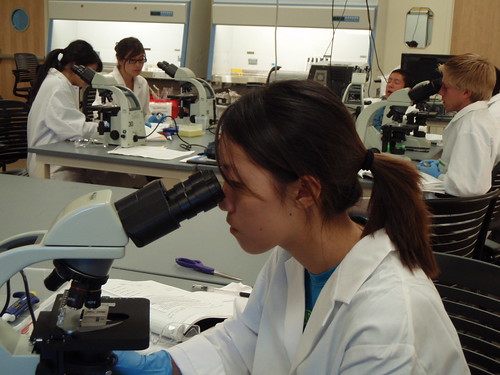
Image : http://www.flickr.com
The UN Convention on Biological Diversity states, "Biotechnology is any technological application that uses biological systems, living organisms, or derivatives thereof, to make or modify products or processes for specific use". The OECD (the Organization of Economic Co-operation and Development) defines biotechnology as "...the application of scientific and engineering principles to the processing of materials by biological agents". Thus, "Biotechnology" basically means using biology as the basis for a technology that is applied to research and product development in areas such as agriculture, food science, and medicine.
The Academic Standards for Science and Technology defines Biotechnology as the ways that humans apply biological concepts to produce products and provide services. This is very true if we consider a section of biotechnology in which the directed manipulation of organisms is used for the product of organic products such as beer, milk products, food etc.
Biotechnology had already been performed long before the term itself was coined, though on a very basic level. For example, man had already learnt the method of fermenting fruit juices to concoct alcoholic beverages during the period around 6000 BC. However, it was considered more of an art then. Biotechnology became a real science only about two decades ago when genes were found to contain information that would enable the synthesis of specific proteins. This was in the 1970s, when new advances in the field of molecular biology enabled scientists to easily transfer DNA - the chemical building blocks that specify the characteristics of living organisms - between more distantly related organisms.
Then in the mid-eighties and early-nineties, it was confirmed that the transformation or modification of the genetic structure of plants and animals was very possible. The introduction of "Transgenic" animals and plants also led to more resistance to disease and increased the rate of productivity etc. Modern biotechnology is also now more often than not associated with the use of genetically altered microorganisms such as E. coli or yeast for the production of substances like insulin or antibiotics. New innovative biotechnology application such as plant-made pharmaceuticals has also now been developed.
Sub-fields in Biotechnology:
Red Biotechnology is the use of genetically altered microorganisms for the production of substances like insulin, antibiotics, vitamins, vaccines and proteins for medical use, and is thus related to medical processes. Genomic manipulation is also an example of Red Biotechnology.
Biomanufacturing or White Biotechnology is emerging field within modern biotechnology which involves the designing of organisms such as moulds, yeasts or bacteria, and enzymes to produce certain useful chemicals, and is related to the industrial sector. It is also known as Grey Biotechnology.
Green Biotechnology or agricultural Biotechnology, like the name suggests, is the area of biotechnology involving applications to agriculture. This basically involves the genetic manipulation of plants and animals in order to create more productive, environmentally friendly, disease resistant species. An example of traditional agricultural biotechnology is the development of disease-resistant wheat varieties by cross-breeding different wheat types until the desired disease resistance variety is achieved.
http://biotechnology-hq.com/ Biotechnology HQ: articles and information about the science of biotechnology.
No comments:
Post a Comment